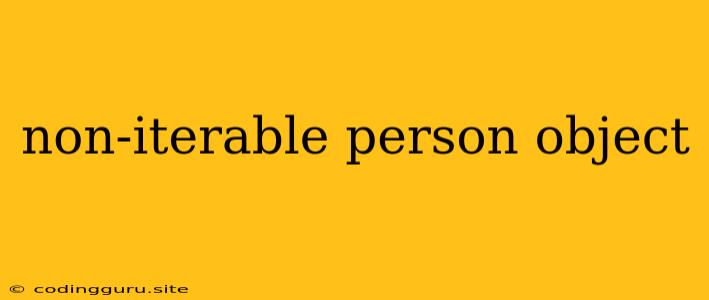The "Non-Iterable Person Object" Problem
In the realm of programming, particularly within the context of object-oriented languages, the concept of iteration is often employed to traverse through collections of data. Iteration allows us to access each element of a collection, one by one, enabling us to process and manipulate the data within. However, when dealing with objects that represent real-world entities, such as "Person" objects, the question of whether they are "iterable" or not becomes a critical point of consideration.
This article will delve into the nature of "non-iterable Person objects," exploring why such objects might exist, the challenges they present, and how to best approach working with them.
What is a "Person" Object?
A "Person" object in software development typically encapsulates information about an individual. This information can range from basic details like name, age, and address to more complex attributes such as medical history, employment details, or social media profiles. The specific attributes of a "Person" object will vary depending on the application it serves.
Why Might a "Person" Object Be Non-Iterable?
The iterability of an object is determined by its underlying structure and how it is designed to interact with iterators. A "Person" object might be non-iterable due to several reasons:
-
Simple Data Representation: The "Person" object might be designed as a simple data container with no inherent ordering or sequential structure. For example, if the object only holds name, age, and gender, there might be no natural order to traverse through these properties.
-
Lack of Implementation: The "Person" object may not have implemented the necessary methods to support iteration. In some programming languages, like Python, iteration requires the object to implement the
__iter__and__next__methods. Without these, the object cannot be directly iterated over. -
Purposeful Design Choice: The developers might have intentionally designed the "Person" object to be non-iterable, perhaps because iteration is not a primary use case for the object.
Challenges of Working with Non-Iterable "Person" Objects
When dealing with a non-iterable "Person" object, programmers may encounter certain challenges:
-
Direct Access to Attributes: To access individual attributes of the object, you must explicitly reference them by name, rather than using an iterative approach. This can lead to verbose and repetitive code, especially when working with a large number of attributes.
-
Looping Through Data: Iterating through collections of "Person" objects can become difficult without using alternative methods. You might need to create temporary arrays or dictionaries to store specific attributes for subsequent processing.
-
Compatibility Issues: Many libraries and frameworks expect objects to be iterable. Attempting to use such libraries with non-iterable "Person" objects might lead to errors or unexpected behavior.
Solutions for Working with Non-Iterable "Person" Objects
Despite the challenges, several approaches can be employed to overcome the limitations of non-iterable "Person" objects:
-
Custom Iterator: You can define a custom iterator class that takes a "Person" object as input and provides the necessary functionality for iteration. This allows you to access the attributes of the object sequentially.
-
Data Transformation: Convert the "Person" object into an iterable data structure, such as a list or dictionary. This can be achieved by extracting the relevant attributes from the object and placing them into a new data structure.
-
Library Support: Utilize libraries or frameworks that provide specific functions for working with non-iterable objects. Some libraries might offer methods to iterate through object properties or provide alternative approaches to accessing and manipulating data.
-
Object Modification: Modify the original "Person" object to implement the necessary methods for iteration. This requires changing the underlying code of the object, which might not always be feasible.
-
Alternative Structures: Consider using alternative object structures, like collections or data structures that inherently support iteration. This might involve redesigning the "Person" object to better suit your needs.
Examples
Example 1: Custom Iterator (Python)
class Person:
def __init__(self, name, age, address):
self.name = name
self.age = age
self.address = address
class PersonIterator:
def __init__(self, person):
self.person = person
self.attributes = ['name', 'age', 'address']
self.index = 0
def __iter__(self):
return self
def __next__(self):
if self.index < len(self.attributes):
attribute = self.attributes[self.index]
self.index += 1
return getattr(self.person, attribute)
else:
raise StopIteration
person = Person("John Doe", 30, "123 Main St")
for attribute in PersonIterator(person):
print(attribute)
Example 2: Data Transformation (JavaScript)
function Person(name, age, address) {
this.name = name;
this.age = age;
this.address = address;
}
const person = new Person("Jane Doe", 25, "456 Oak Ave");
const personData = {
name: person.name,
age: person.age,
address: person.address,
};
for (const key in personData) {
console.log(`${key}: ${personData[key]}`);
}
Conclusion
Working with non-iterable "Person" objects presents unique challenges, but with proper understanding and appropriate solutions, these challenges can be overcome. By utilizing custom iterators, data transformation, library support, or even object modification, you can effectively access and manipulate the attributes of non-iterable "Person" objects.
Remember that the best approach will depend on the specific context, programming language, and your overall design goals. It's important to carefully consider the trade-offs and choose the solution that best suits your needs.
